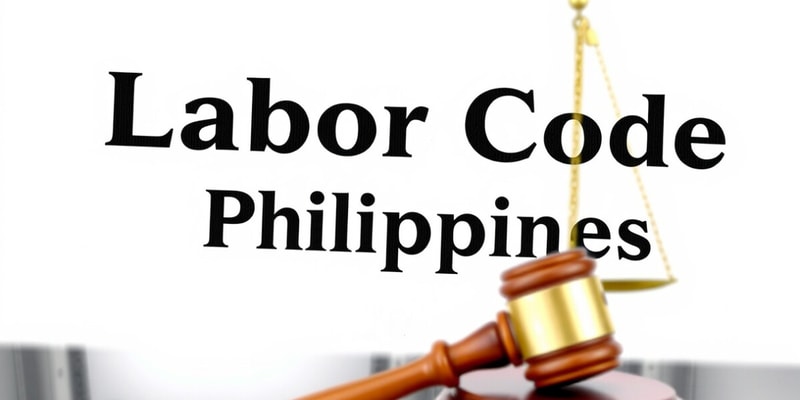Questions and Answers
What type of action is entitled to indigenous peoples to address historical discrimination in employment?
Which agency is responsible for overseeing the implementation of Equal Employment Opportunity laws?
Which of the following is NOT a provision of Equal Employment Opportunity laws?
What is required for an employee to transition from probationary to regular status?
Signup and view all the answers
What must employers follow when terminating an employee?
Signup and view all the answers
What type of discrimination does Disparate Treatment refer to?
Signup and view all the answers
Which of the following best describes a protected classification under EEO laws?
Signup and view all the answers
Which statement about maternity leave is accurate?
Signup and view all the answers
What does the term 'Protected Groups' refer to?
Signup and view all the answers
What obligation do employers have regarding health and safety?
Signup and view all the answers
What does Equal Employment Opportunity (EEO) primarily promote in the workplace?
Signup and view all the answers
Which of the following is NOT a basis for discrimination prohibited by the Labor Code?
Signup and view all the answers
Which provision specifically aims to protect the rights of women in the workplace?
Signup and view all the answers
What does the equal pay provision in EEO laws entail?
Signup and view all the answers
Which aspect of EEO laws provides additional support for vulnerable populations in the workforce?
Signup and view all the answers
What is the maximum number of hours in a standard workweek in the Philippines?
Signup and view all the answers
Which of the following provisions is NOT explicitly mentioned under EEO laws?
Signup and view all the answers
What must employers provide to facilitate the participation of persons with disabilities in the workforce?
Signup and view all the answers
Which of the following is a requirement for regular employees under the Labor Code in the Philippines?
Signup and view all the answers
What type of action is encouraged to address the historical discrimination of certain sectors in employment?
Signup and view all the answers
Study Notes
Equal Employment Opportunity (EEO)
- EEO promotes non-discriminatory practices in employment.
- Governed by the Philippines Labor Code, specifically Book II, Title II, Chapter III.
Maternity and Paternity Leave
- Female employees entitled to paid maternity leave.
- Male employees can avail of paternity leave.
Labor Standards
- Labor Code outlines standards like rest periods, holidays, and night shift differentials.
Health and Safety
- Employers must ensure a safe and healthy work environment.
- Regulations exist to enforce workplace safety.
Employee Associations
- Employees have the right to form labor unions or workers' associations.
Employment Discrimination
- Defined as unjust treatment based on age, race, gender, or religion.
- Key categories include protected classifications and protected groups.
Protected Classification
- Includes categories protected against discrimination such as age, gender, ethnicity, and disabilities.
Protected Groups
- Sub-categories within protected classifications, such as racial groups under skin color protection.
Disparate Treatment
- Involves different treatment based on race, gender, or other protected characteristics.
- Occurs when an employer intentionally treats an employee unfairly compared to others.
Persons with Disabilities
- Employers are encouraged to employ individuals with disabilities and provide reasonable accommodations.
Affirmative Action
- Sectors like indigenous peoples may receive affirmative action to counter historical discrimination.
Labor Standards and Conditions
- Covers working hours, rest days, overtime pay, and related employment issues.
Oversight of EEO Implementation
- Monitored by the Department of Labor and Employment (DOLE) and the Civil Service Commission (CSC).
Minimum Wage
- Minimum wage law establishes region-specific wage rates, adjusted for inflation.
Regular Employment
- Distinction between regular and non-regular employment; regular employees receive benefits like paid leave.
Probationary Period
- New hires can undergo a probationary period for performance evaluation.
Termination and Severance
- Employers must adhere to due process in employee termination; valid grounds and procedures are outlined in the Labor Code.
Working Hours
- Standard workweek is 48 hours over six days; overtime pay is mandatory for hours exceeding this.
Critical Points on EEO Laws
- Non-discrimination policies in hiring practices.
- Mandate for equal pay for equal work regardless of personal characteristics.
- Specific protections for women, including maternity leave and night work restrictions.
Learning Outcomes
- Students will identify and describe employment discrimination.
- Discussion of EEO laws in the Philippines using case analysis.
State Policy on Employment
- State promotes hiring based on skills and qualifications rather than age.
- Prohibition of arbitrary age limits in employment practices.
Learning Outcomes
- Ability to identify and describe employment discrimination visually.
- Capacity to discuss the Philippines' Equal Employment Opportunities (EEO) laws through case analysis.
- Awareness of laws and regulations relevant to the teaching profession and responsibilities under the Code of Ethics.
Equal Employment Opportunity (EEO)
- Aims to promote employment based on abilities, knowledge, skills, and qualifications rather than age.
- Prohibits arbitrary age limitations in employment.
- Governed by the Philippines Labor Code, specifically Book II, Title II, Chapter III.
Key Aspects of EEO Laws
- Non-discrimination in employment based on age, sex, gender, sexual orientation, marital status, disability, religion, ethnicity, or political affiliation.
- Equal pay for equal work is mandated regardless of personal characteristics.
- Protects women's rights in the workplace through specific provisions, like banning night work in certain industries and maternity leave benefits.
- Encourages the hiring of persons with disabilities and requires reasonable accommodations.
- Enforces affirmative action for historically discriminated sectors, such as indigenous peoples.
- Covers labor standards, including working hours, rest days, and overtime pay.
Oversight of EEO Implementation
- Managed by the Department of Labor and Employment (DOLE) and the Civil Service Commission (CSC).
Employment Discrimination Definition
- Unjust or prejudicial treatment based on age, race, gender, religious beliefs, etc.
Important Provisions Under EEO Laws
- Minimum Wage law sets district-specific minimum wage rates; adjusted for inflation and cost of living.
- Regular employees receive benefits like paid leave and health insurance.
- A probationary period allows employers to evaluate new hires.
- Procedures for employee termination must follow due process as outlined in the Labor Code.
- Standard workweek is 48 hours, typically across six days, with overtime pay requirements.
- Female employees are entitled to maternity leave, while male employees receive paternity leave.
- Labor standards cover rest periods, holidays, and night shift differentials.
- Employers must maintain a safe and healthy working environment.
- Rights of employees to form and join labor unions are protected.
Protected Classifications and Groups
- Protected classifications include age, gender, ethnicity, and disability, shielding these groups from employment discrimination.
- Protected groups are subsets of protected classifications (e.g., white, black, brown under skin color).
Disparate Treatment vs. Disparate Impact
- Disparate Treatment: Intentional different treatment based on race, gender, religion, etc.
- Examples include hiring practices favoring one group over another despite identical qualifications.
- Disparate Impact: Indirect discrimination from facially neutral policies that adversely affect a protected group.
- Even unintentional discrimination, such as hiring based on height, can disproportionately impact certain groups (e.g., fewer women hired due to height criteria).
Studying That Suits You
Use AI to generate personalized quizzes and flashcards to suit your learning preferences.
Description
This quiz covers important aspects of the Philippines Labor Code, including Equal Employment Opportunity (EEO), maternity and paternity leave policies, labor standards, and health and safety regulations. It also discusses employee rights regarding associations and discrimination laws. Test your knowledge on these vital labor topics!




